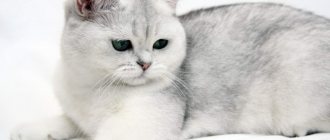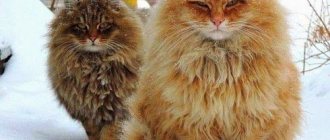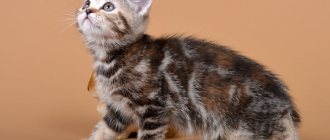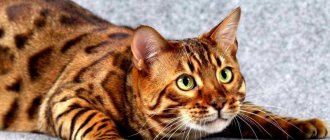Review author: “ZooVita”
Among the 36 breeds recognized by the International Federation of Cat Fanciers, the Russian Siberian cat occupies a worthy place.
Noble appearance, generous character, courage, friendliness - these are the qualities of the breed that attract cat lovers.
Story
The origin of the Siberian differs from most known breeds. Many of the currently existing cat species were bred after lengthy breeding work. Siberian, according to experts, is the result of natural selection. The cat was brought to the territory of Siberia by pioneers in the 17th-18th centuries.
No one was specifically involved in selection, and felinologists (specialists who study cats) believe that the formation of the breed was significantly influenced by the crossing of local and Persian cats.
Buying a kitten
Choosing a kitten is a responsible step, because you are purchasing not just an animal, but a new family member who will become your faithful friend for the next two decades.
A Siberian pet will definitely become a member of your family, so you should take its choice seriously
Some tips:
- Prepare theoretically in advance: try to learn as much as possible about the characteristics of the Siberian breed and the rules for its maintenance.
- “Try on” the cat to your home conditions: think about where he will eat, sleep, go to the toilet, and play.
- Be sure to come to a consensus with all your family on the issue of purchasing a cat - the animal will feel comfortable if it does not bother anyone.
- In a timely manner, select everything necessary for the kitten: bowls for food and water, a tray, a scratching post, combs and toys, stock up on food.
And of course, the most important thing is to decide what kind of kitten, where and why you want to buy. As has already been said, there is nothing wrong with even bringing a cat into your home from the street, much less buying it at a bird market or borrowing it from friends. There are a lot of options - but none of them guarantee that a miracle will happen and thus a truly purebred animal will appear in your home. There is little chance that it will be at least healthy and with a stable nervous system.
A kitten from the street or from friends may differ from the breed standards, even if it looks very similar to a Siberian
How to choose
If you want guarantees, choose a reliable breeder first, and only then a kitten. The choice of nurseries that breed the Siberian breed today is quite large, and they all value their reputation. They will help you choose a child based on his expected prospects and your ambitions.
Remember that a show-class animal can cost several times more than just a pet, which will delight you no less. But if you plan to participate in exhibitions and breeding, then it is better to purchase an older kitten - its qualities can be assessed more accurately. In all other cases, you need to choose a baby no younger than two and a half months - by this age he must be vaccinated and accustomed to at least the basic rules of independent living in a new home.
Do not buy a kitten that is too small - let him grow up a little next to his mother, who will teach the basic rules of cat behavior in the house
If possible, talk to the baby's parents - their appearance and behavior can outline the characteristics of the pet you choose. Listen to the breeder's recommendations - this will help you properly raise a healthy and beautiful animal.
Description rules
At the end of the 20th century, the current standard was approved, which distinguishes one breed from another. Existing canons of breed interpretation include taking into account the following factors:
- the weight of an elite representative of the species;
- height at withers;
- head shape;
- eye color and shape;
- tail;
- wool;
- general appearance of the physique.
Compliance
According to the standard descriptions of the Siberian cat, its data should be as follows:
- The body weight of an adult animal should reach ten kg.
- Height at the withers is forty centimeters for a male, ten centimeters less for a cat.
- The head is large. It allows the presence of tufts on the ears, which gives the Siberian a resemblance to its wild relative – the lynx.
- The eyes are oval, slightly slanted, and the color is either greenish or yellow.
- Fluffy and moderately long tail.
- A purebred cat must have two undercoats and an outer coat that is impermeable to water. In summer, Siberians look like short-haired breeds; only the tail remains fluffy. With the onset of cold weather, a cute collar appears, and the hind legs are decorated with fluffy “pants.” Well, the tail fluffs up even more.
Breed characteristics
Siberian beauties are usually medium in size, males are larger.
The body is stocky with well-developed muscles, covered with dense, medium-length hair. The hairs of the undercoat are thin but dense. The head is trapezoidal with low and wide cheekbones. The forehead is low, but clearly visible and sticks out a little. The ears have the shape of an isosceles triangle with rounded tips.
The eyes are oval-shaped, slightly slanted. Shades of yellow and green predominate. Blue color, as well as mixed eyes, are possible in the colors van and white.
Siberian cat, color point color, always with blue, deep eye color.
Diseases
By nature, cats of the Siberian breed have excellent health. Experts believe that only a person with an incorrectly formulated diet and poor care can disrupt the animal’s good health. This is partly true, but at the same time cats can suffer from:
- urolithiasis;
- shortness of breath, lethargy and cough in old age.
In addition, prolonged loneliness can develop extreme excitability and activity in a cat.
Hair getting into the stomach of a pet also causes unpleasant consequences. Typically, a cat gets rid of hairballs using the gag reflex. In some cases, you should help the purr - give a tablespoon of sunflower oil. A teaspoon will be enough for a kitten.
In case of urolithiasis or senile ailments, you should contact a veterinarian.
How much does it cost to choose and care for a kitten?
Kittens of the Siberian breed are not uncommon nowadays. They can often be found walking in the yard. It is better to purchase a baby from a nursery or from a familiar breeder. This is the only way to be sure that your baby has received the necessary vaccinations.
The cost of a Siberian kitten depends on the color of the coat. The price of purebred representatives can reach 10–30 thousand rubles.
It is quite simple to distinguish a Siberian kitten from an ordinary one. The babies are large in size, they are strong, with powerful paws. The tail is very fluffy. Another distinctive feature is the fluffy collar. The change of teeth in kittens begins at 3–4 months.
As for the name, this is at the discretion of the animal’s owner. You can name the cat a girl: Umka, Tigger, Taiga. Also common cat names for girls: Athena, Artemis, Bast, Bessie. A suitable nickname for a boy: Boniface, Baron, Marquis, Ermak, Push or Pushok, Stefan. The cat can also be named: Caesar, Romka, Boris.
Kitten weight by month
The table below will help you determine how much a kitten should weigh.
| Age | Kitten weight by month boy | Girl |
| Newborn | 110 grams | 100g |
| 2 months | 3 kilograms | 1.5 kilograms |
| 5–6 months | 5–6 kilograms | 2–3 kilograms |
| 12 months | 5–7 kg. | 3–4 kg. |
An adult Siberian cat can weigh up to 12 kilograms. Siberian kittens, unlike other cats, grow for quite a long time. The animal reaches full maturity by 4 years of its life.
Color
The photo of Siberian cats shows how different colors breeders do not tempt potential buyers! Among the most popular we note the following:
- tricolor;
- ginger;
- brick;
- golden and silver;
- tortoiseshell;
- two-color;
- the coat has a blue tint, and the nose and paws are gray.
There are several other colors, for example, the gray Siberian cat and the Neva masquerade, but the federation of cat lovers has not yet approved them as a standard.
Please note ⭐⭐⭐
Oriental cat: characteristics of the breed, health, care and maintenance, rules for raising a kitten, price (150 photos)
Neva Masquerade cat: photo, description of breed and character, size, weight and color, pros and cons of the St. Petersburg cat
American shorthair cat: description of the breed, its character and care, nutrition (100 photos)
The color of a kitten's coat is determined by the influence of parental melanin. In nature, there are two types of this substance - black and red. The interaction of colors is the basis for the formation of all existing colors. The exception is the white color of animals.
How to choose a kitten
If the future cat owner has finally decided that he wants a kitten of the Siberian breed, then the most reasonable thing would be to contact a specialized and certified nursery or a reputable breeder. Fortunately, the price for a kitten of the Siberian breed is more than humane - from 2,500 rubles, if the cat owner wants a purring pet, without problems with breeding and without admission to exhibitions.
Two kittens, two cheerful friends...
If you want to compete for exhibition awards, then the price for the corresponding kitten will be much higher - from 15,000 rubles. But the cat owner will receive a pet with a brilliant pedigree. Is it worth it or not - everyone decides for himself.
Choosing the right Siberian kitten is not difficult:
- Read the articles “Where do cats come from in the house” (in it we tell in detail how and what you should pay attention to when visiting a breeder) and “Getting a kitten: what you need to know in advance” (how to prepare your home for the arrival of a kitten and what you should consider in advance to avoid troubles in the future).
- The optimal age at which a kitten can be adopted is 3.5 months.
- If you plan to breed and participate in exhibitions, then you should pay attention to clubs certified by FIFe and WCF. They treat breed standards more responsibly than non-certified and private breeders.
Siberian beauty
Conditions of detention
Maintaining a furry creature will not require much effort or time. Siberian purrs quickly get used to the tray and are neat and clean. Since cats have rather hard hair, it does not form tangles and does not need frequent brushing. It is enough to brush your fluffy beauty once a week. True, during the spring and autumn molting period the procedure will have to be carried out more often.
The Siberian cat does not like water and should be washed only after a walk in nature. During the water procedure, it is necessary to tightly close the ears with cotton wool, and the water temperature should be in the range of 38-39 degrees.
Considering the strength of Siberians, it is better to wash a cat together. After the “bath”, you need to thoroughly wipe your pet and let it dry in a warm room where there are no drafts.
Important! Regular cleaning of the ears is necessary, and the corners of the eyes should be wiped with a damp cotton swab.
Nutrition
Cats are not picky when it comes to food, but having an excellent appetite and knowing the weaknesses of their owners, they abuse this and beg from them for various delicacies.
Please note ⭐⭐⭐
Burmese cat - photo of the sacred cat, pet care and keeping at home (110 photos)
British shorthair cat - features of cat care, its colors, selection of proper nutrition (110 photos)
Ragdoll - 120 photos, description of appearance and color, her character, how she gets along with other pets
Recommended diet:
- raw lean beef (need to be doused with boiling water);
- poultry meat;
- boiled sea fish;
- dairy products (cottage cheese, cheese, fermented baked milk).
Kittens, nursing mothers and cats expecting offspring benefit from low-fat cream and goat's milk.
As supplements, you can give boiled egg yolk and a minimum amount of dry food of the highest quality.
Many cat lovers accustom their pets to rice, buckwheat and oatmeal porridge.
Table: pros and cons of the Siberian breed
| Breed Features | pros | Minuses |
| Character | Calm and balanced | Sometimes vindictive, vindictive and aggressive |
| Content | Easy to maintain and care | Requires regular brushing and walking |
| Nutrition | Can eat both ready-made food and natural food | Tends to overeat and is picky about food |
| Health | High resistance to diseases | Predisposition to joint pathologies |
This is interesting
- The first mention of Siberian cats dates back to the 16th century. But then they were called Bukhara cats.
- Representatives of this breed are excellent hunters. Having a Siberian cat in the house, you can forget about the existence of any rodents.
- Cats are wonderful fathers and help their “wives” raise their children.
- They are distinguished by monogamous relationships. Cats enter into a “love” relationship with only one cat.
- Siberians are independent and independent creatures. These kinds of pets are suitable for people who do not have the opportunity to devote a lot of time to their pets. Without its owners, the cat will not be bored, but will find something to do to its liking.
- Tortoiseshell males, as a rule, do not give birth to offspring.
- Siberian cats get along well with small children and dogs.
- They recognize only one owner; the rest of the household, at best, are considered only their equals.
- They love boiled shrimp and for the sake of this delicacy they can resort to “blackmail”, refusing to eat other foods.
Character and behavior
The Siberian cat, despite its great weight and apparent massiveness, is a very agile, jumping and fast creature. At a young age, he will not miss the opportunity to be pampered; as he matures, he becomes more sedate, but not lazy. The sense of self-esteem of these furry egg-bottles is “overflowing,” so don’t expect that the cat can be squeezed and stroked whenever you want. If the “Siberian” is in a good mood, he himself will ask you for a portion of affection, but if the cat is not in a good mood, it is better not to bother him - he begins to snap back and may even give you a paw.
He has a subtle instinct: if the owner has problems, he will never impose himself, but will sit on the sidelines and wait for the right moment.
Of all the family members, he chooses one “leader” for himself, and perceives the rest as his personal servants. He will faithfully wait for his owner from work, sleep on his things, meet him at the door and cuddle. They don't like loneliness. A Siberian cat definitely needs personal toys and its own closed house, where it can hide and relax from others.
Treats guests condescendingly. He quickly finds a common language with pets, but prefers to maintain neutrality: he is unlikely to sleep side by side with another cat or dog.
Name the cat who always wanted to live together
BasilioLeopold
It takes root well both in an apartment and in a private house. The last option is better: Siberian cats need walks in the fresh air, love to climb trees and bushes, and hunt for birds and moles. Without physical activity, she will feel “out of place,” so take her for walks more often, and put up a special complex at home with ladders and shelves.
Excellent hunters: from an early age they fearlessly hunt insects, mice and birds. Therefore, it is not worth having either one or the other in the apartment.
They adore small children: they know how to babysit them, try to protect them from strangers, play and indulge with them. At the same time, the claws never extend, do not hiss or snort, even if the child hurts the cat.
He quickly remembers his name and the commands “eat”, “drink”, “play”, “walk”. There are no problems with the tray.
This breed often develops hyperexcitability as it ages. And, unfortunately, the main activity occurs at night, when people want to sleep.











